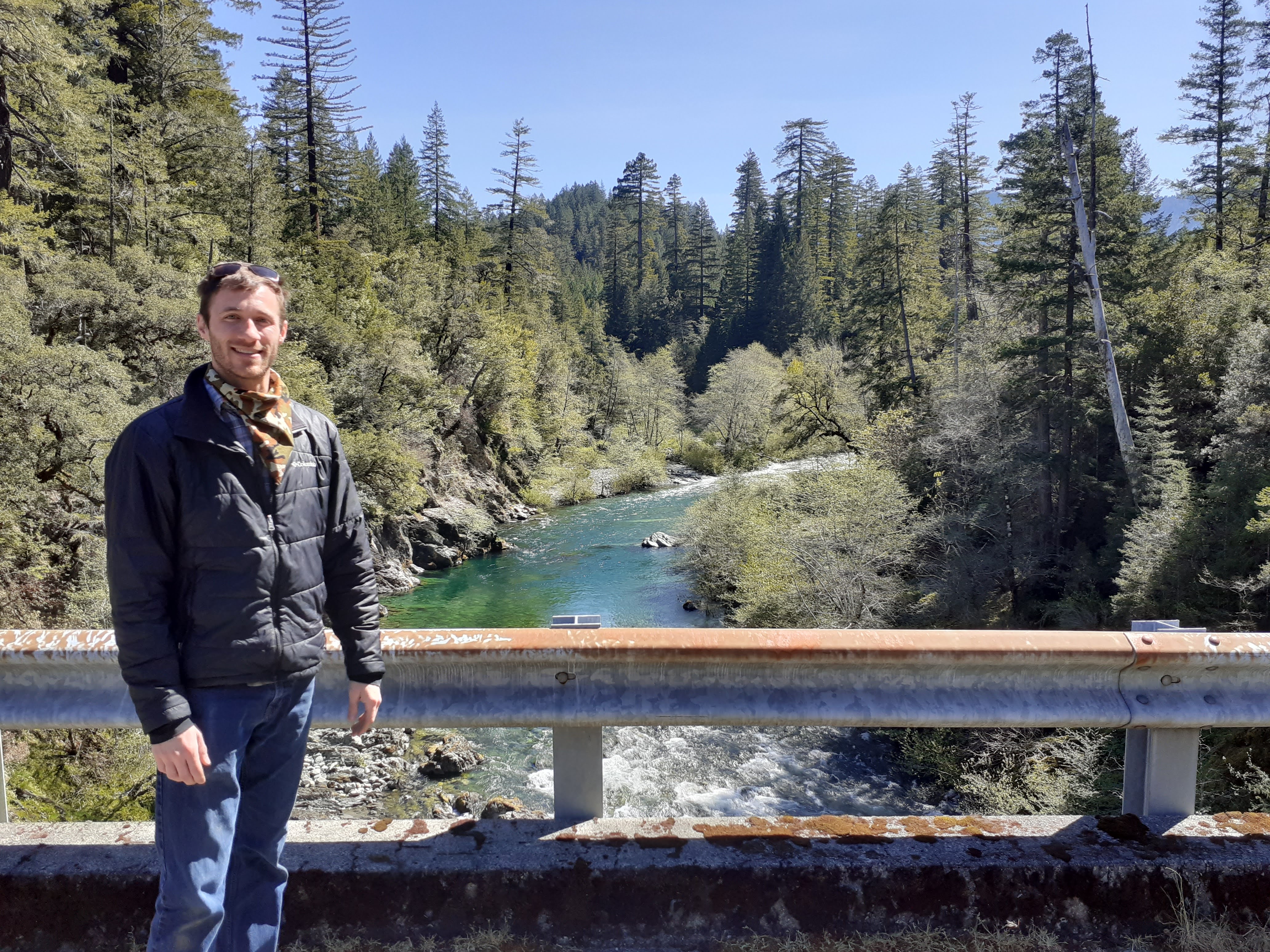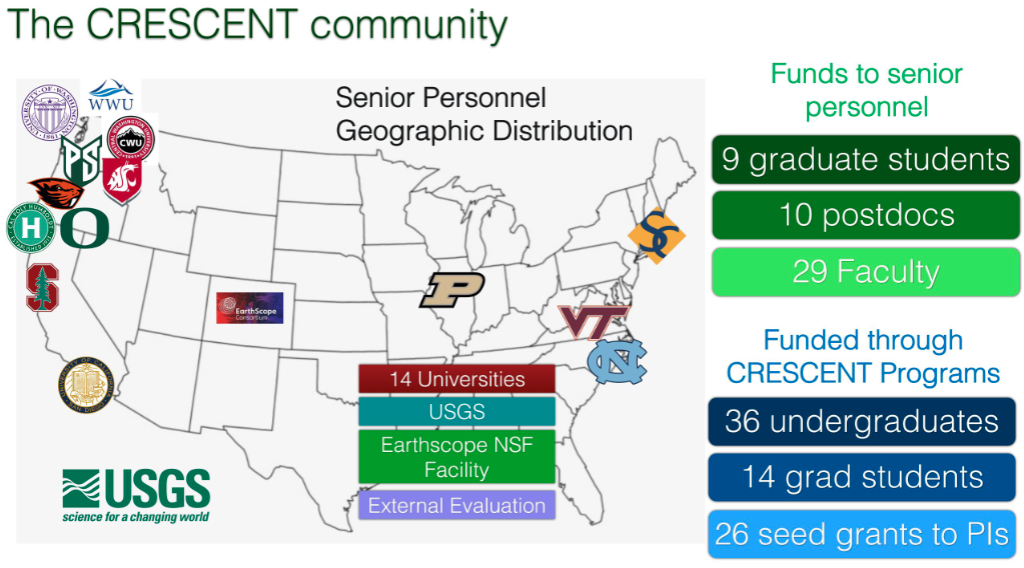NSF award creates new center to study subduction earthquakes and associated hazards
09-26-2023

Dr. Jonathan Delph near the Smith River in northern California where he was recently conducting a seismic experiment to understand how earthquakes are related to subduction zone processes in the Pacific Northwest. He is an Assistant Professor with Purdue University’s Department of Earth, Atmospheric, and Planetary Sciences (EAPS) and is a senior member of the “Cascadia Velocity Model” for the newly created CRESCENT center which will study subduction earthquakes. Photo by EAPS graduate student Vincent Sassard.
Jonathan Delph of Purdue will help lead the charge on creating and synthesizing datasets to predict shaking from earthquakes
Subduction occurs when one tectonic plate slides beneath another, and results in the largest and most devasting earthquakes on Earth. Accurate predictions of when earthquake shaking will occur and where it will be the strongest can save lives and aid in policy development for resilient infrastructure. It is of vital importance to understand how earthquakes work, which is why the National Science Foundation (NSF) has recently announced a $15 million grant to support the creation of the Cascadia Region Earthquake Science Center (CRESCENT). This center will be devoted to understanding earthquake and earthquake-related hazards along the subduction margin of the Pacific Northwest in the United States.
The CRESCENT headquarters is located within the University of Oregon but includes scientists from 14 universities across the United States, the US Geological Survey, the Earthscope NSF Facility, along with various stakeholders and policy makers in the Pacific Northwest region. Dr. Jonathan Delph, of Purdue University’s Department of Earth, Atmospheric, and Planetary Sciences, will be a senior member of the “Cascadia Velocity Model.” This group’s focus is to create a seismic property model that will be able to accurately model seismic waves from earthquakes to estimate both when shaking occurs and how violent this shaking will be.


The NSF funded CRESCENT program is located within the University of Oregon but includes scientists from 14 universities across the United States, the US Geological Survey, and the Earthscope NSF Facility, along with various stakeholders and policy makers in the Pacific Northwest region. Graphic by Diego Melgar of the University of Oregon, and Director of the new center.
The center will unite scientists like Delph, who study the structure of the Cascadia subduction zone, an offshore tectonic plate boundary that stretches more than 1000 kilometers from southern British Columbia to northern California, with those that investigate the possible effects and impacts of a major earthquake on infrastructure and society. The NSF grant for the newly created center will span five years.
“The main goal of the center is to bring together the large group of geoscientists working in Cascadia to march together to the beat of a singular drum,” said Diego Melgar, director of the new center and associate professor of earth sciences at the University of Oregon. “The center organizes us, focuses collaboration, and identifies key priorities, rather than these institutions competing.”
The Cascadia subduction zone has a long history of spurring large earthquakes, but scientists have only started to realize its power within the last few decades. Research shows that the fault is capable of producing an earthquake of magnitude 9.0 or greater—and communities along the U.S. West Coast are ill-prepared for a quake this powerful.
A magnitude 9.0 or greater earthquake in the Cascadia subduction zone could set off a cascade of deadly natural hazards in the Cascadia region, from tsunamis to landslides. It could cause buildings and bridges to collapse, disrupt power and gas lines, and leave water supplies inaccessible for months.
Of the 16 institutions involved in CRESCENT, Delph explains that “Purdue's specific goals are to create and systematically analyze a 3D model of the seismic properties of the Cascadia margin that can be used to accurately simulate the timing and amplitude of shaking from both large and small earthquakes along the Cascadia margin. The goal of the project overall is to understand the seismogenic dynamics and behavior of the Cascadia margin to make the Pacific Northwest (Cascadia) region more resilient to seismic hazards. This will be done by combining geophysical (seismic, geodetic), geologic (field observations in structure, tsunamigenesis), and computational (machine learning, earthquake simulation) approaches.”
Delph is part of the team that runs the Computational Seismology and Tectonics lab at Purdue University. This team maintains and manages multiple broadband seismometers and provide near real-time feeds from these instruments which are integrated with in the Central and Eastern US Network of seismic monitoring.
Scientists within CRESCENT will gather data and develop tools to better forecast specific local and regional impacts from a quake. That knowledge will help communities to better prepare, by providing information needed to improve infrastructure, and nail down more informed emergency plans. Building resiliency in the region to face of “The Big One” is a much greater task than any institution can undertake on its own. Through the collaboration, community engagement, and scientific advances that CRESCENT enables, the Cascadia region’s shaky foundations will be strengthened.
About the Department of Earth, Atmospheric, and Planetary Sciences at Purdue University
The Department of Earth, Atmospheric, and Planetary Sciences (EAPS) combines four of Purdue’s most interdisciplinary programs: Geology & Geophysics, Environmental Sciences, Atmospheric Sciences, and Planetary Sciences. EAPS conducts world-class research, educates undergraduate and graduate students, and provides our college, university, state and country with the information necessary to understand the world and universe around us. Our research is globally recognized, our students are highly valued by graduate schools, employers, and our alumni continue to make significant contributions in academia, industry, and federal and state government.
Writer: Cheryl Pierce, Communications Specialist
Contributor: Dr. Jonathan Delph, Assistant Professor at the Purdue University Department of Earth, Atmospheric, and Planetary Sciences